With the amazing weather continuing in Seattle, we wanted to find somewhere we hadn’t been in a while to spend Friday and Saturday night. A couple years ago on Jammy we stayed with Jo and Dick at Port Orchard Marina, so Josh, JJ and I decided to try it again.
I had the opportunity to play around with some of the new AIS and auto routing features from Raymarine, released in Lighthouse R15 and R16. Everything worked well, and we had a fantastic time.
We departed Elliott Bay Marina around 4:30PM for a 2 hour motor to Port Orchard – we wanted to arrive before it was too dark, and opted not to sail. Crossing Elliott Bay was OK, but once we got out into the channel, the wind was a steady 20 knots from the north gusting to almost 30 with at least 4 foot waves. We were headed across the channel almost directly west, so the waves were not our friends. It gave me the chance to see how Grace handles in a few new situations with the waves behind us.
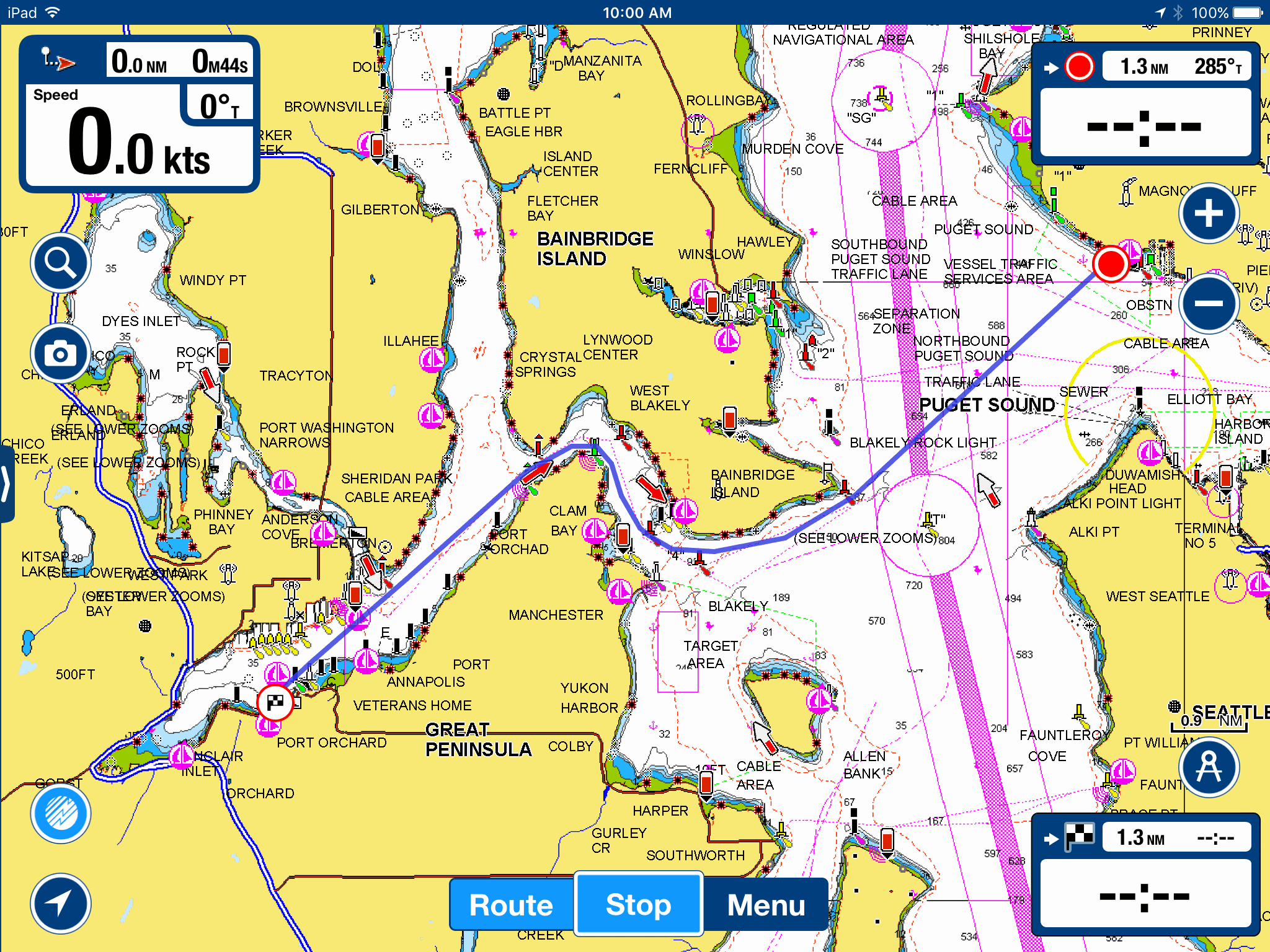
Our route was pretty simple, and I used both the iPad ahead of time, and the auto routing in real-time on my Raymarine eS78 the entire weekend. While it was pretty good last weekend on our trip to Bainbridge Island, it was a bit more aggressive in it’s route this time around. It’s not showing in the screen above, but the eventual course went inside some buoys I didn’t like, as well as went in between Orchard Rocks and some rather permanent fishing barges.
Overall, the auto routing feature is nice to initially setup a route, but I found it too aggressive with corners and turns near hazards, and all during some of the lowest tides of the season. The good thing about the Raymarine created auto routes is that you can move the waypoints, which I was able to do easily, and created a solution that I was happy with. Ben @ Panbo discussed some of the same concerns in his post on Autorouting: Navionics new Dock-to-Dock kicks it up a big notch.
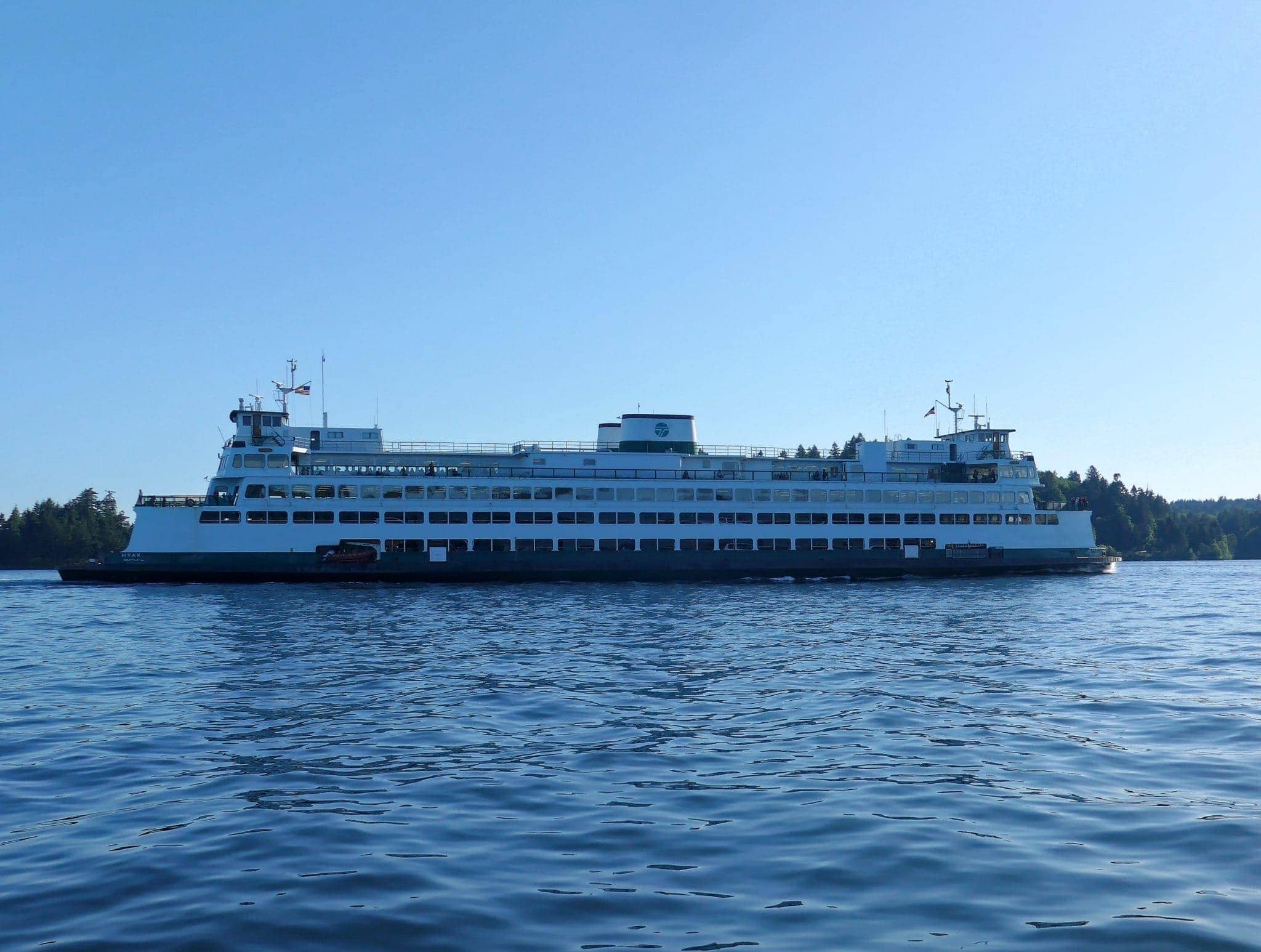
WSF Hyak at Orchard Point headed to Bremerton through Rich Passage
One of the fun parts of the transit to Port Orchard is Rich Passage. You get the opportunity to navigate through a very active tidal area, and usually get a visit or two from the Washington State Ferries that travel between Seattle and Bremertonevery 45 minutes or so. We met the Hyak at Orchard Point, bound for Bremerton. She was at least the minimum 500 foot distance away, but it sure didn’t seem like it! I try to time entering Rich Passage at Orchard Point just when a ferry arrives, and after the Seattle-bound ferry has already exited, that way they get ahead of me in the passage, and I don’t have to pass one whilst inside myself.
Once inside the passage, the waves and wind calmed down considerably, much to the appreciation of Josh and JJ.
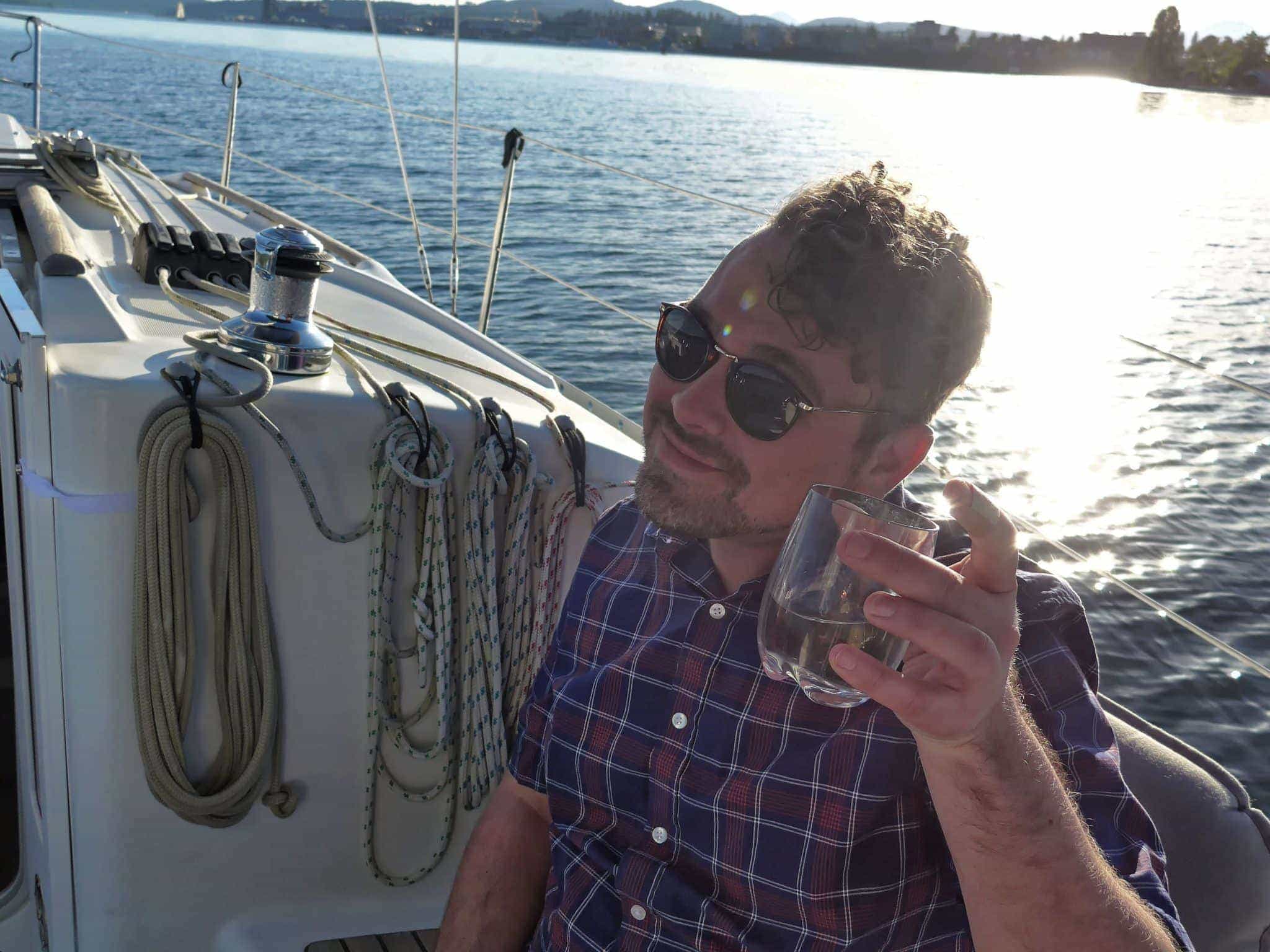
Josh finally able to enjoy a drink in the warm sun just East of Bremerton
The rest of the trip was uneventful, and we tied up at Port Orchard Marina just around 7PM and went out to dinner at Amy’s on the Bay. We had a great evening playing cards and the usual tomfoolery, and woke up the next morning ready to relax in the sun.
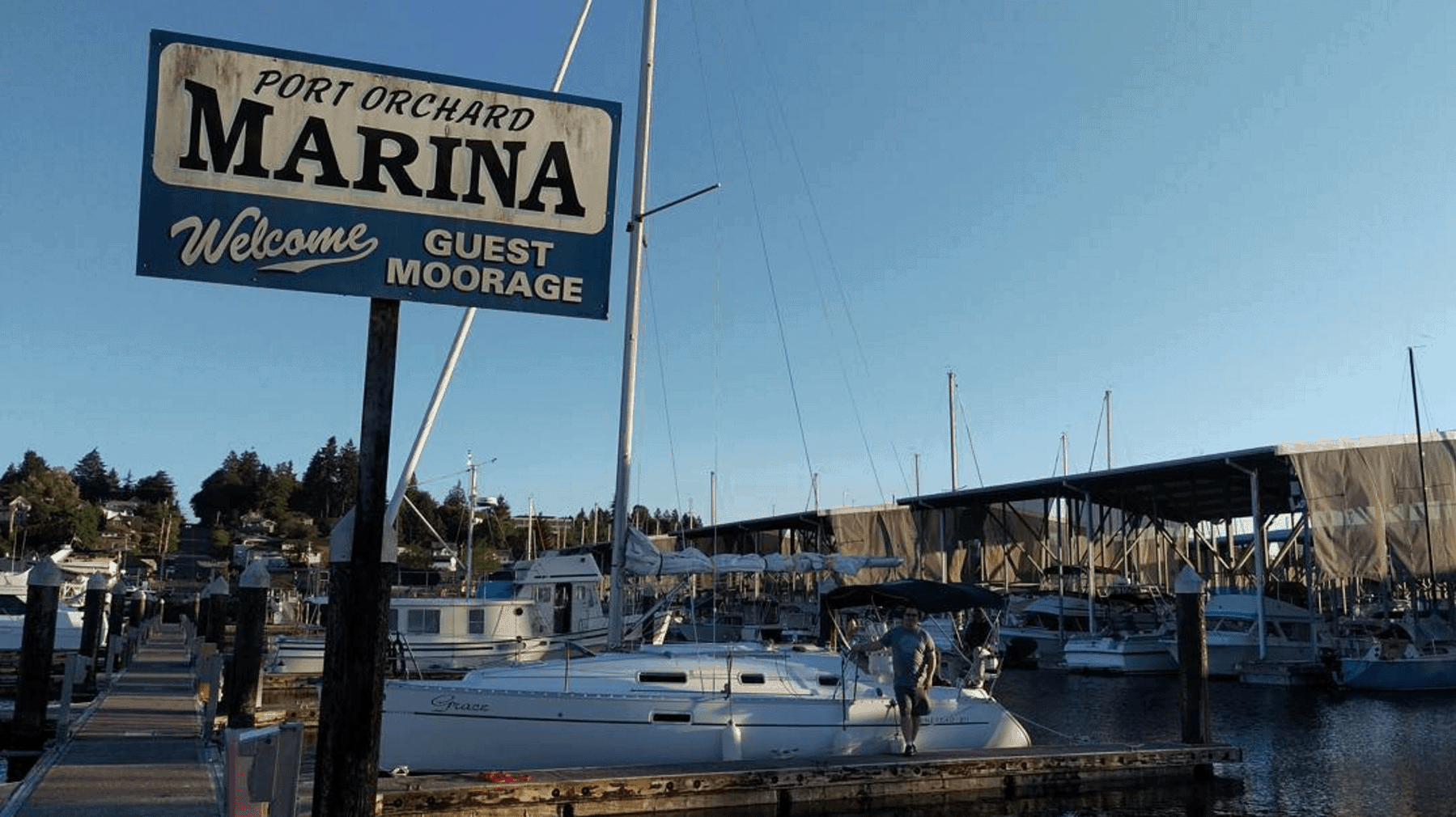
Grace and the author after just arriving at Port Orchard Guest docks
Shoreside, Port Orchard offers one of the best spots to walk along the waterfront that I can remember. Landscaping is immaculate and beautiful, and there are picnic tables, benches, and other spots to loiter. Nearby is a big parking lot for folks visiting the waterfront, and everything seems to slow down a bit compared to busy Seattle. There are nearby restaurants, coffee shops, bars, and a ton of antique places which we will be visiting again. On Saturday, we visited the Port Orchard Farmer’s Market, which had a lot of various stalls to choose from. Both Josh and JJ bought metal figures that were pretty cool. I forgot my camera, so no pictures of that fun!
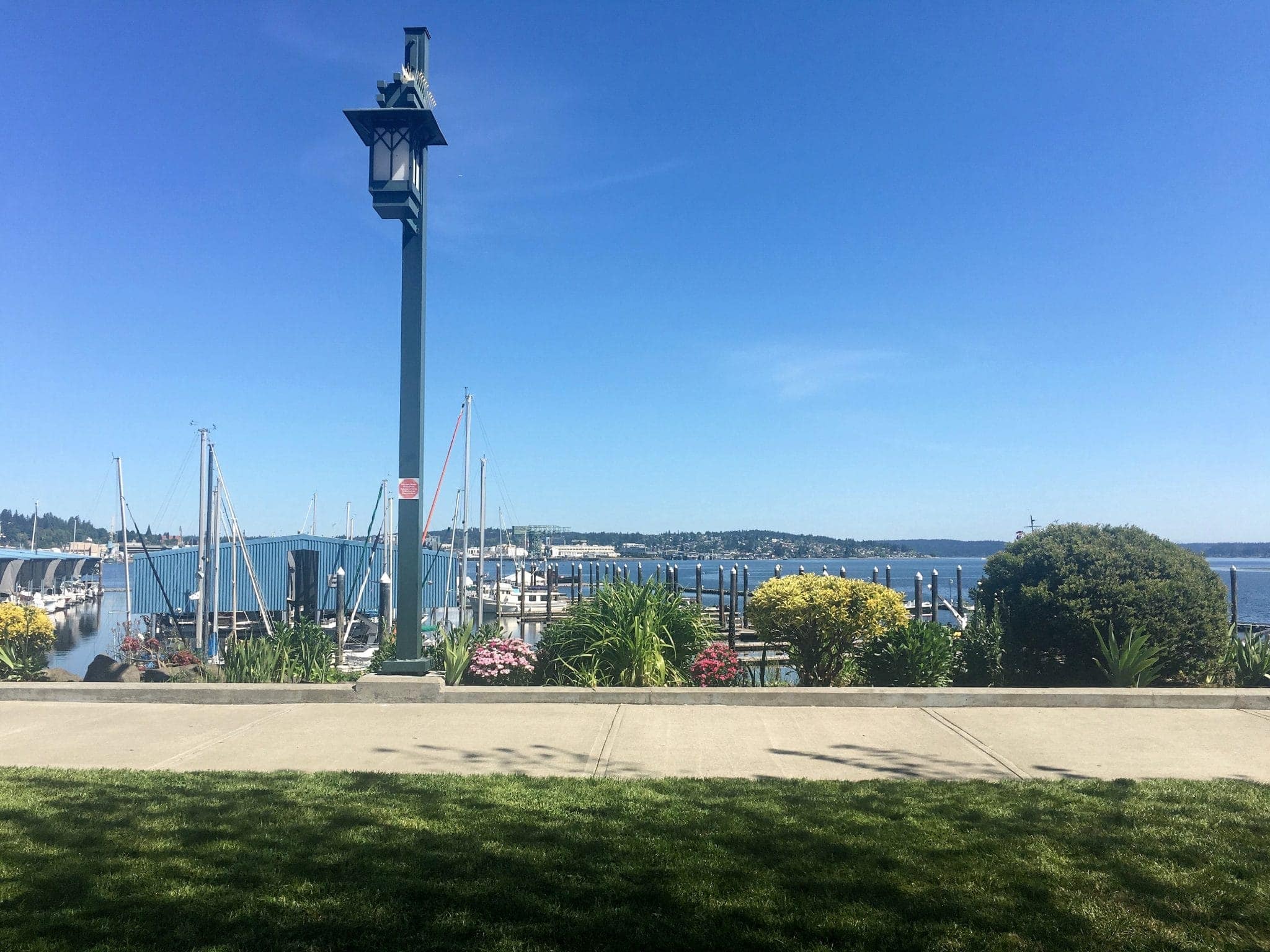
Also nearby is Milltech Marine, where I’ve bought all of my AIS and VHF stuff since 2007. The store was closed on the weekend, but I did get to peek in the windows. I highly recommend if you are looking for anything AIS related that you check out their site – not only do they have a wide selection, but they stand behind what they sell, and will help you figure out any details.
The Port Orchard Marina has both finger slips and a linear dock available for guest moorage. We chose to stay in a finger slip, since the wind was out of the north most of the weekend, and the linear dock offers little protection.
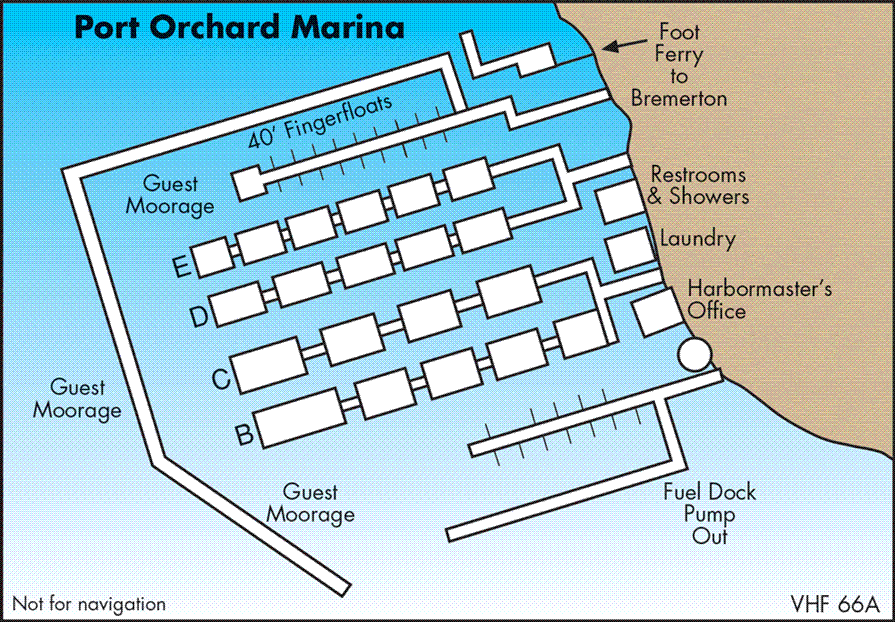
One thing we noticed for the duration of our stay was the wind and wave action that affected us at the dock. The nearby foot ferry created the majority of the waves, and were sometimes significant enough to cause various items to tumble around the cabin or cockpit. The wind also was a factor, coming right down on Grace’s bow and causing lots of adjustments on the lines for the stay. During poor weather from the North or West, this would not be an ideal location.
I grade a large part of my marina experience on the quality of the bathrooms and showers. Port Orchard’s bathrooms look like they have been remodeled recently and are very clean and well maintained. The showers have really big changing areas, and are also well maintained and clean. There’s nothing worse than arriving after a long passage to a shower that makes you want to shower after you shower.
Our experience with the marina staff was excellent – checking in was a breeze on Saturday morning (we came in too late to do it on Friday, which I had pre-arranged) and everything was already in their system and ready based on my call ahead earlier in the week.
The rest of Saturday was spent exploring the town including visiting Moon Dogs Toofor a late lunch and a drink. My parents stopped by for a couple hour visit – they live in Gig Harbor, and had never seen Grace. My dad can’t get around like he used to, and the tides were extreme, and the dock ramp was almost like climbing a ladder, so mom came down for the tour while JJ and Josh chatted with dad.
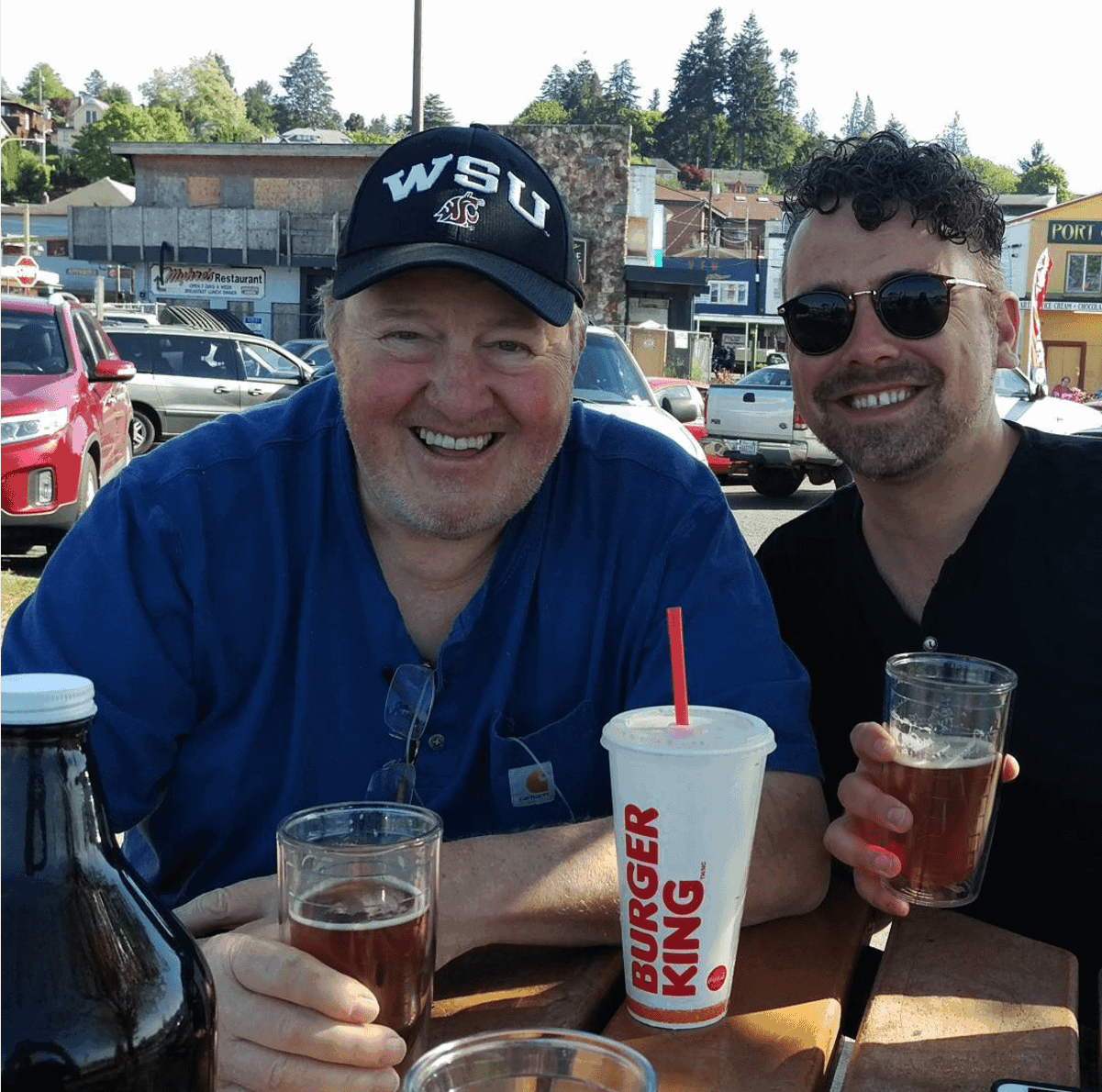
Josh and Dad enjoying the sun
That night we played more card games, and rushed around late at night trying to see the Aurora Borealis that everyone was talking about online, but the light pollution towards Bremerton made it impossible.
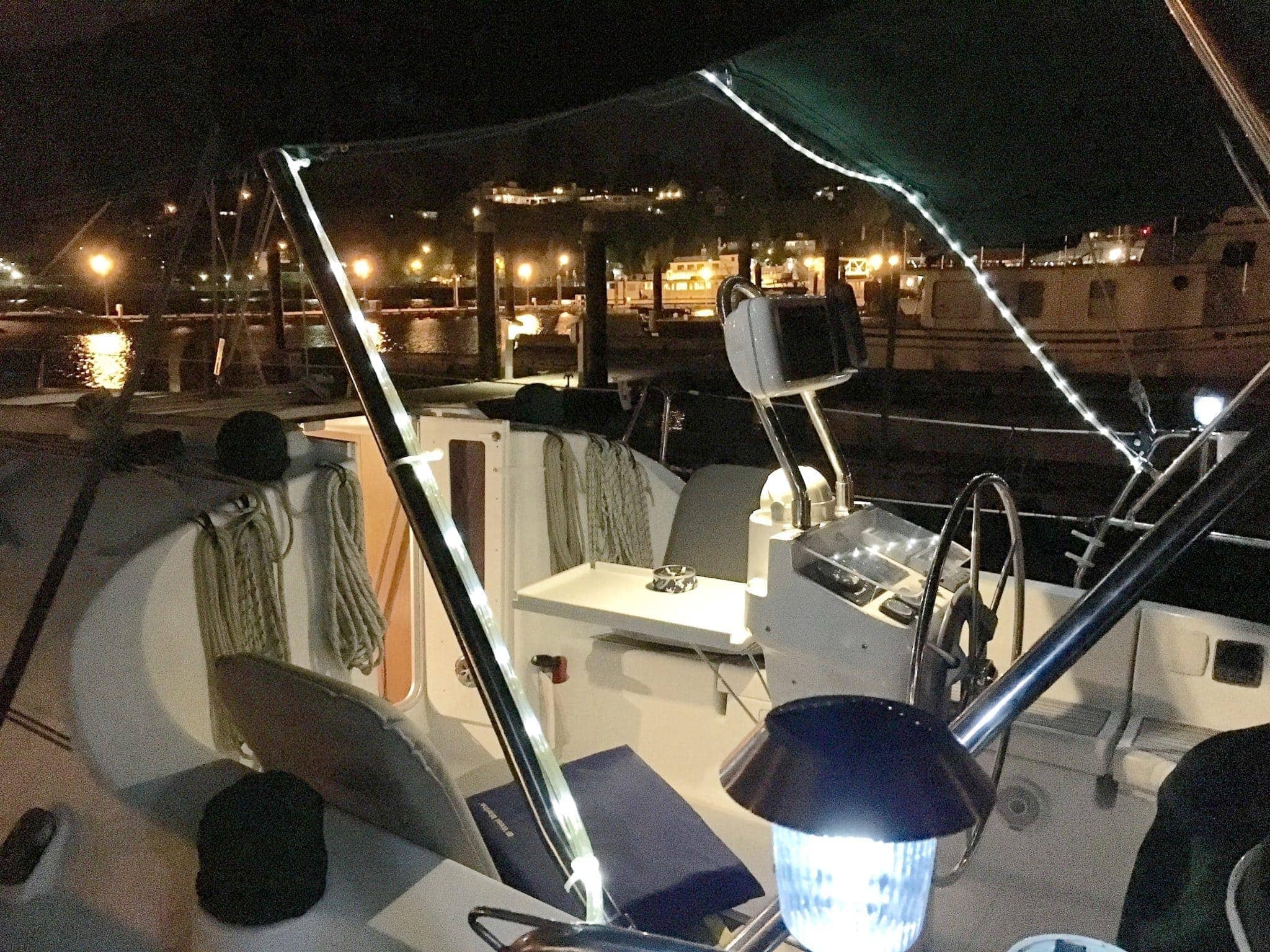
Sunday dawned and our beautiful summer weather had been exchanged for grey skies and a bit of rain.
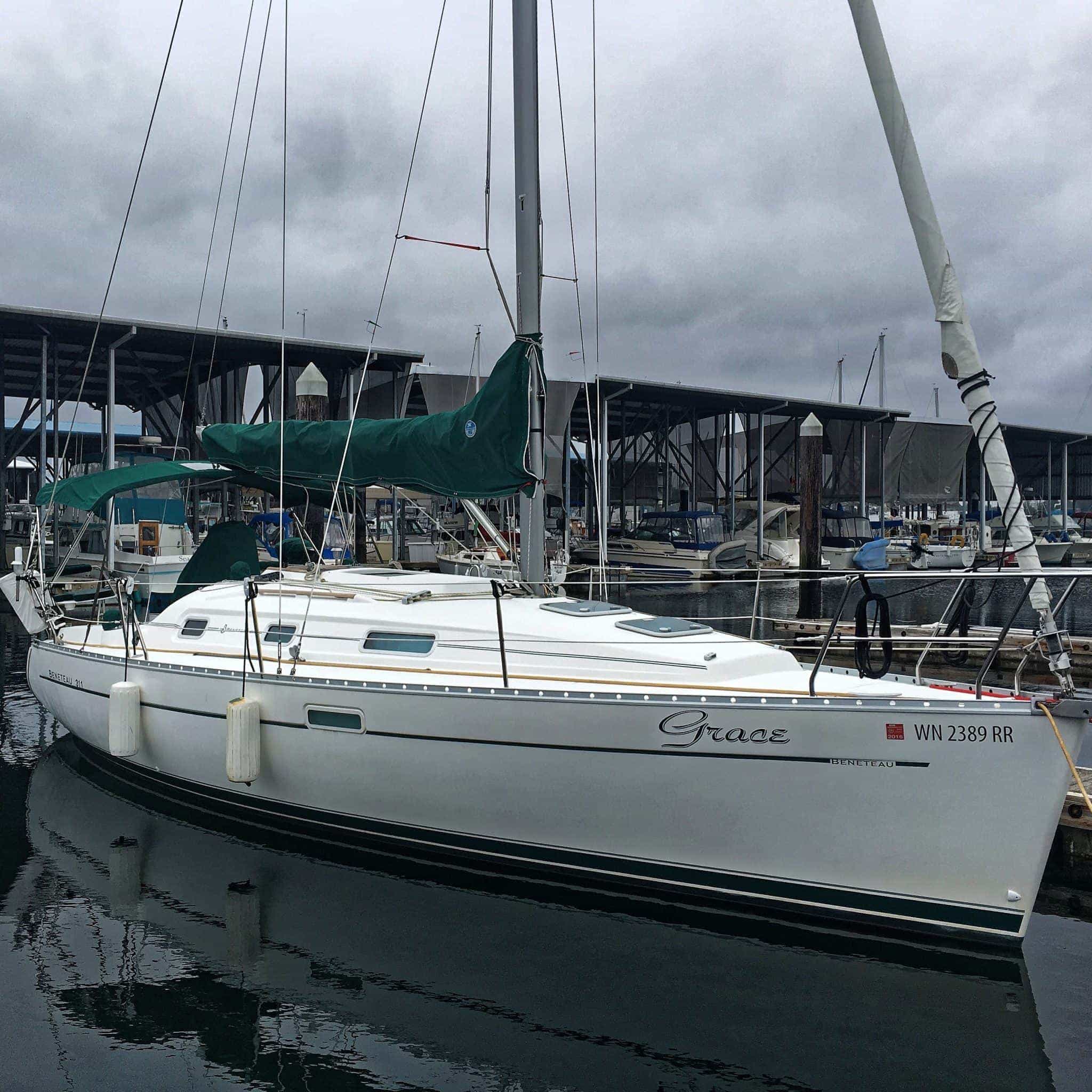
Most of the weekend, we were one of only 4-5 boats on the guest finger piers. There were a few other boats out on the linear moorage, but not many. When we’ve been here before, it’s been fairly open as well.
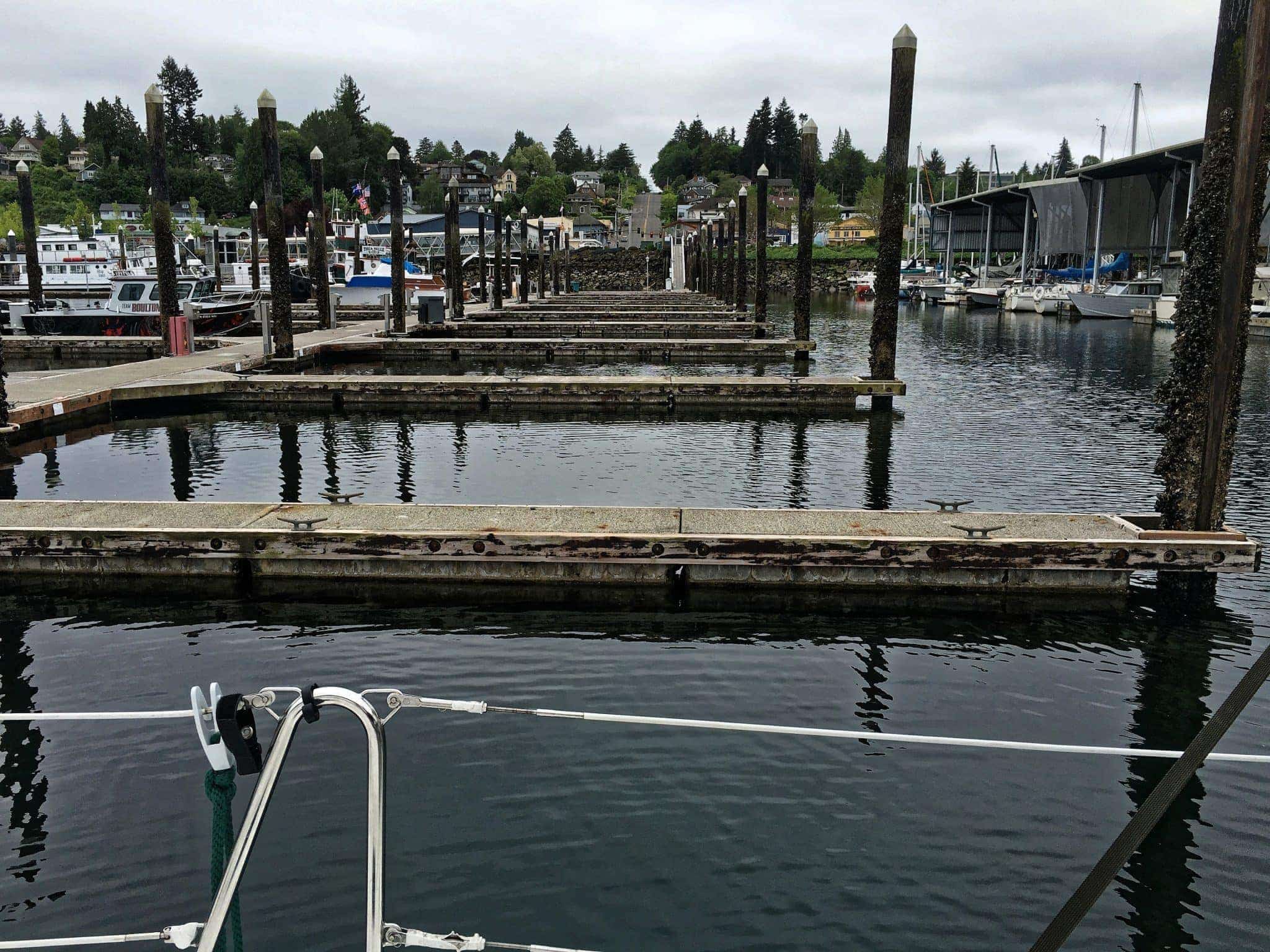
Grace’s view of the empty guest docks
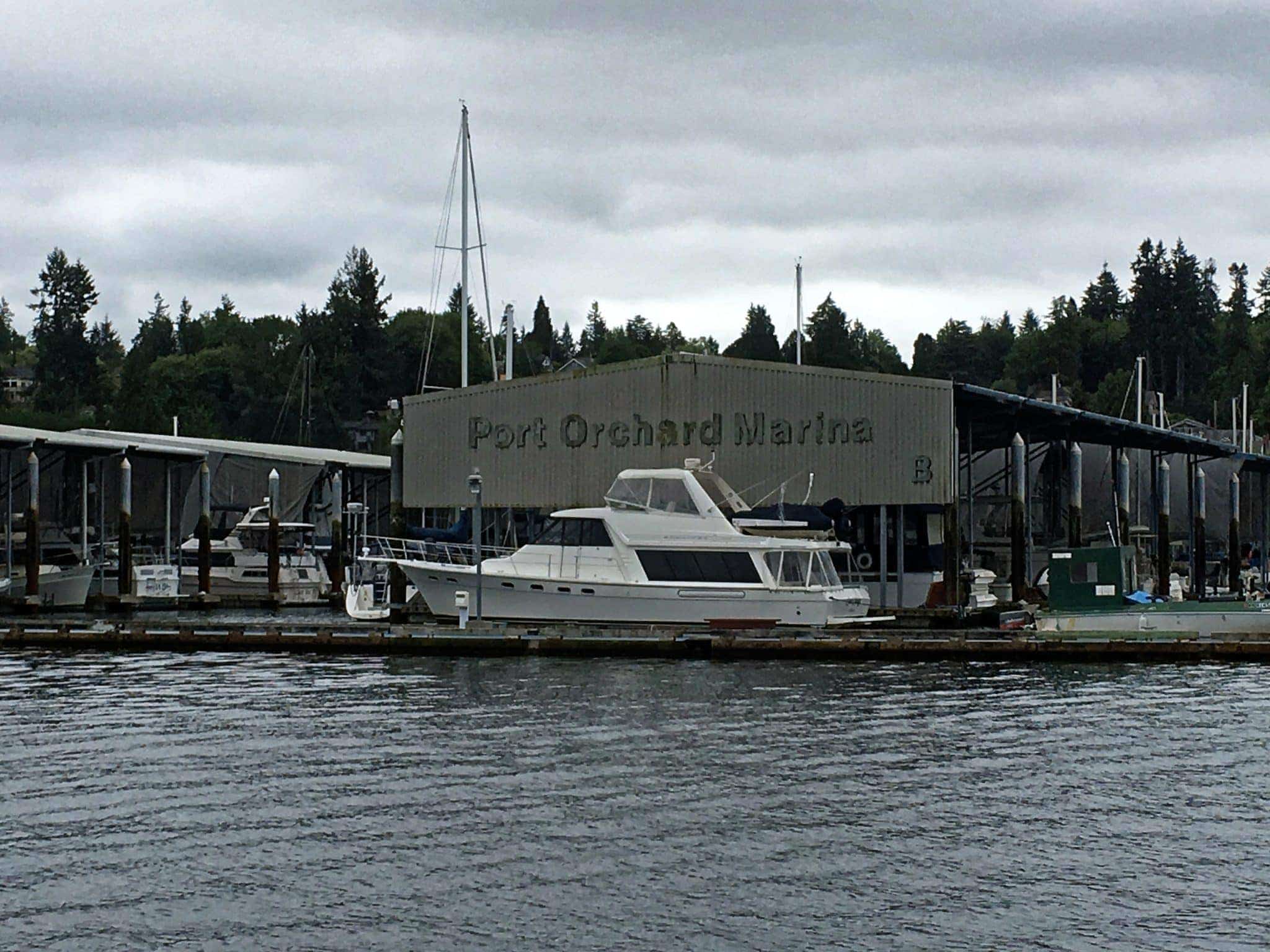
We motored out past Bremerton, and were again in competition with a ferry for a bit as we made our way towards Rich Passage. During this time the tide was changing, and we passed through some of the most dramatic tide rips I’ve ever felt just off the tip of Bremerton Marina.
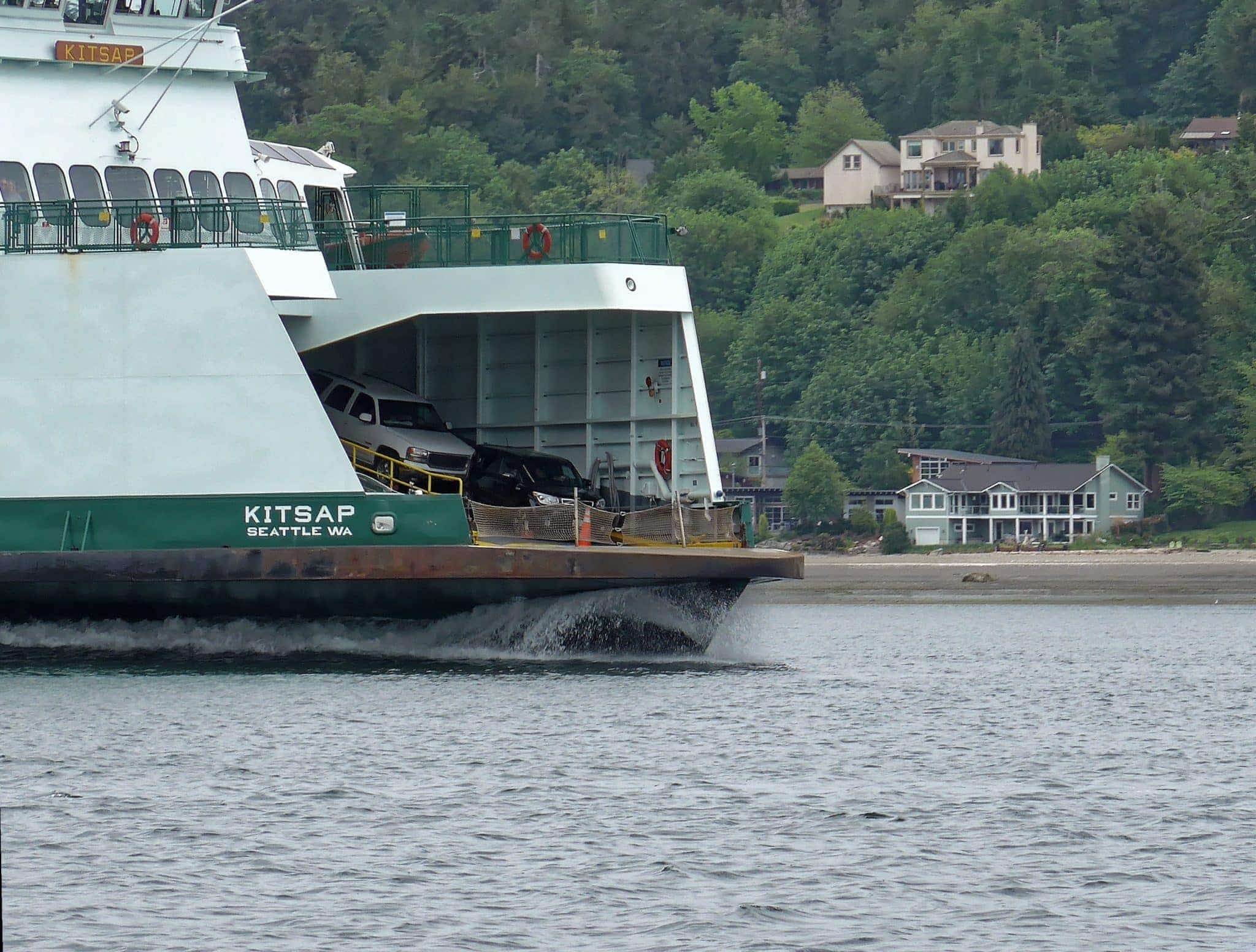
Washington State Ferry Kitsap and it’s bow wake headed towards Bremerton
The tide was to our advantage in the passage – at one point we were moving along at almost 6 knots through the water, but GPS saw us at over 9 knots. Pretty fun!
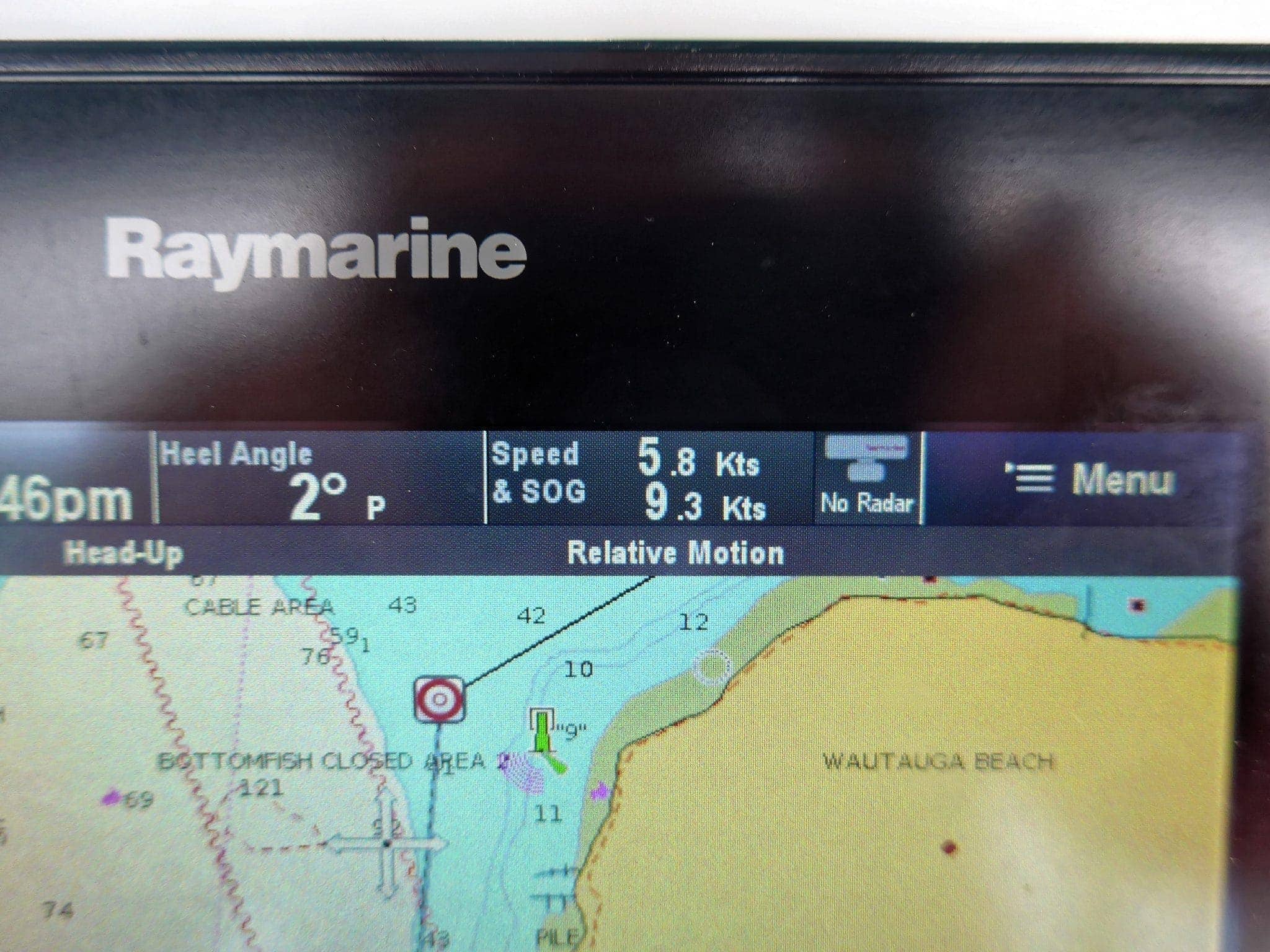
Raymarine MFD showing 3.5 knot advantage through the passage
The tide was still quite low, so I adjusted some of my waypoints from the inbound trip even further out from shore just for safety’s sake.
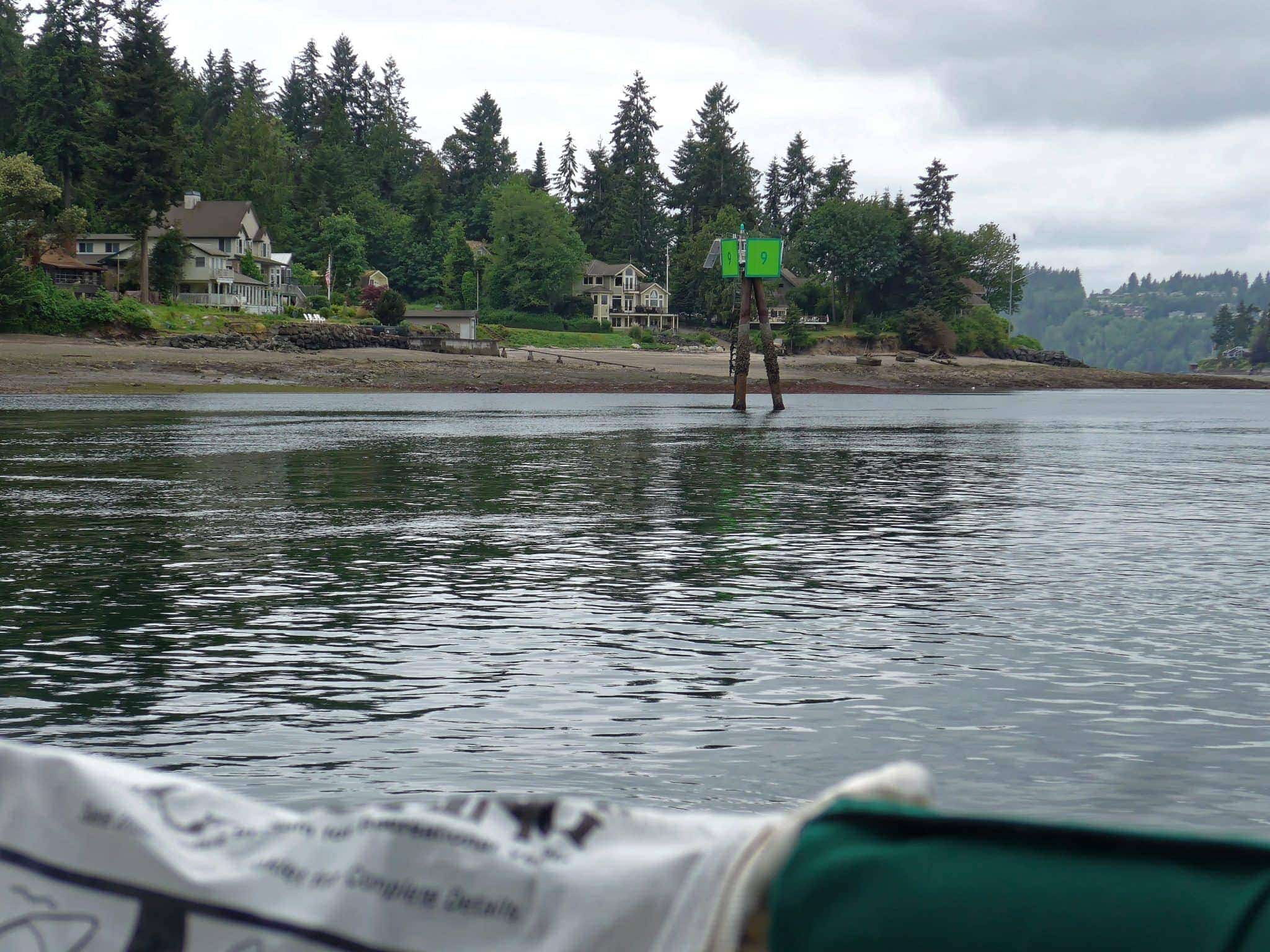
The WSF Kitsap passed us again right as we made the turn at Orchard Point, headed towards Seattle. Waters here were very confused and churning, slowing us at least a knot.
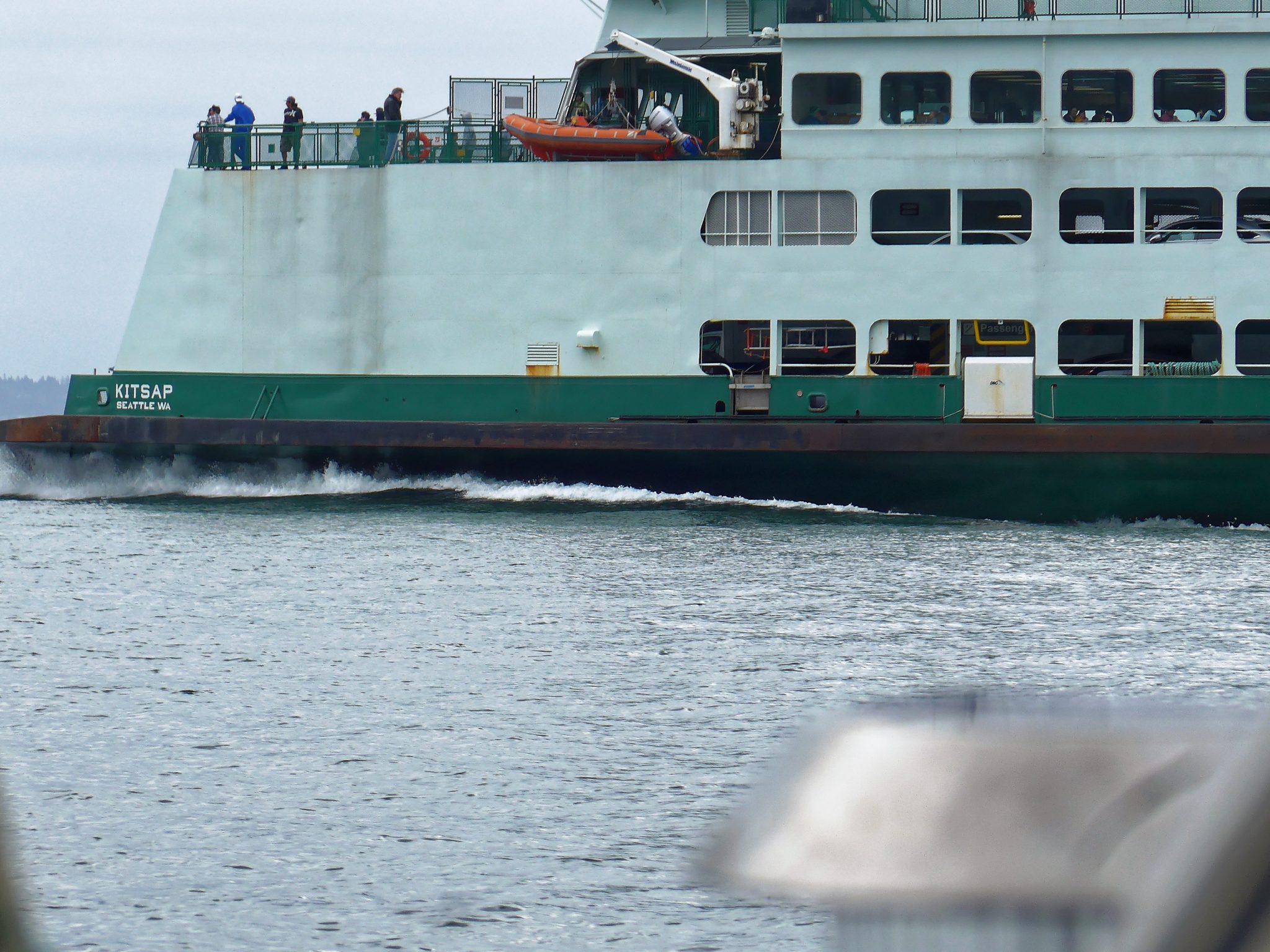
Shortly we could see home and our marina in the distance. Even on overcast days, the views towards Seattle are beautiful.
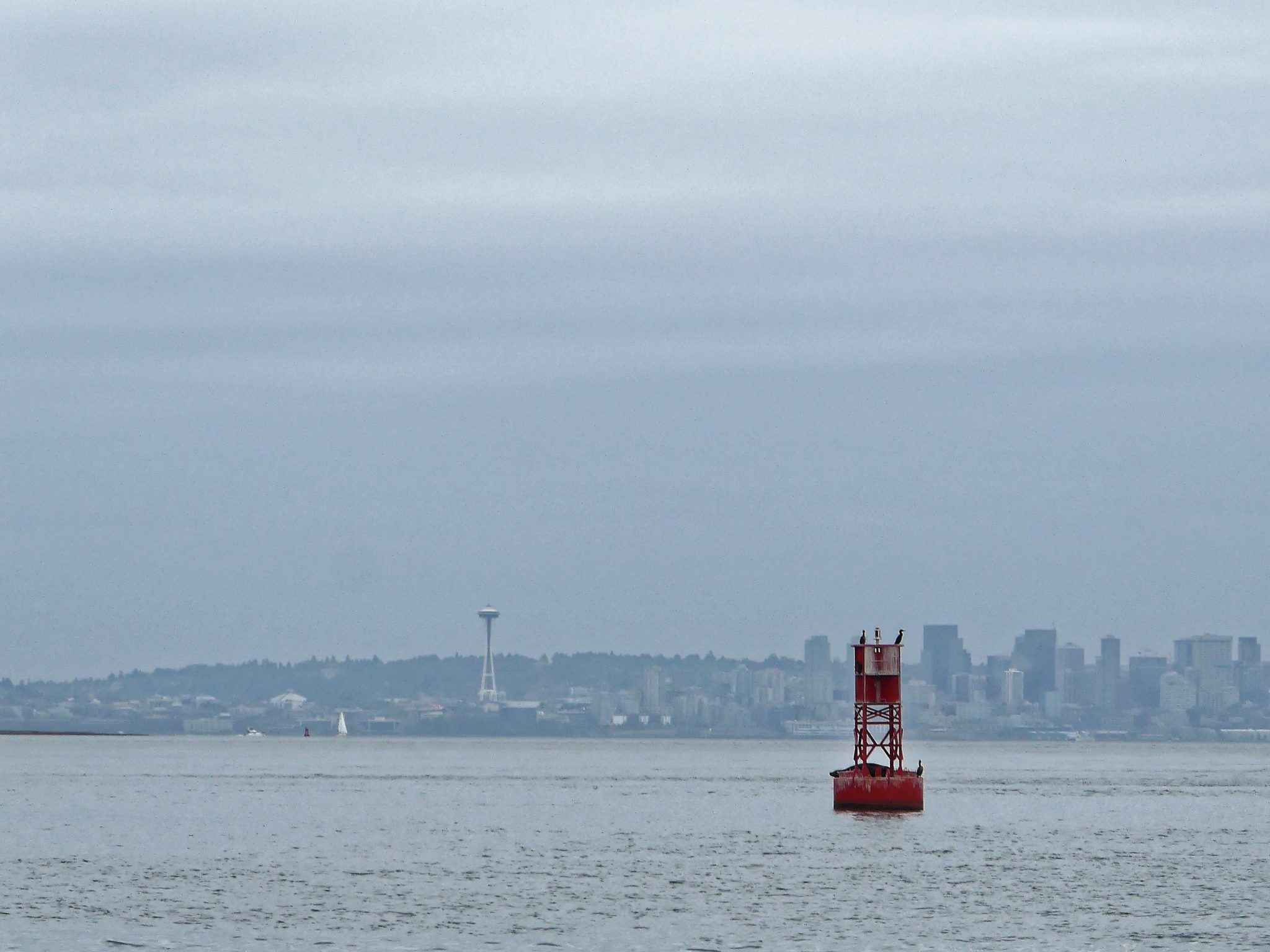
We were rewarded with a pass by the bigger ferries going to and from Bainbridge Island. Can you tell I’m a ferry nerd?
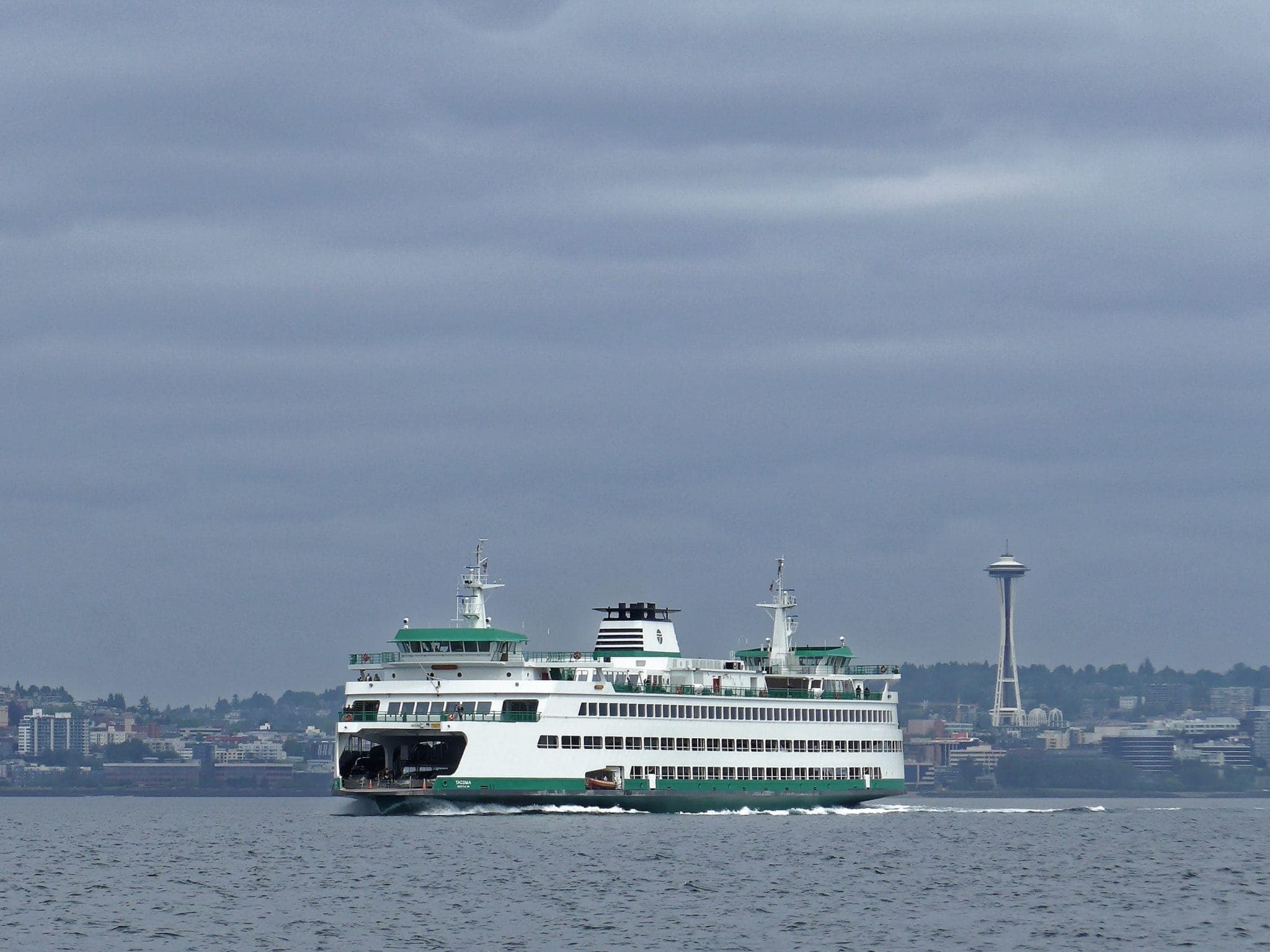
WSF Tacoma headed towards Bainbridge Island
I spent quite a bit of time this weekend playing with the new AIS collision avoidance features Raymarine announced in Lighthouse version 15. The change of symbols along with the interception zones really help in representing clearer dangers based on AIS data, combined with your boat speed and course.
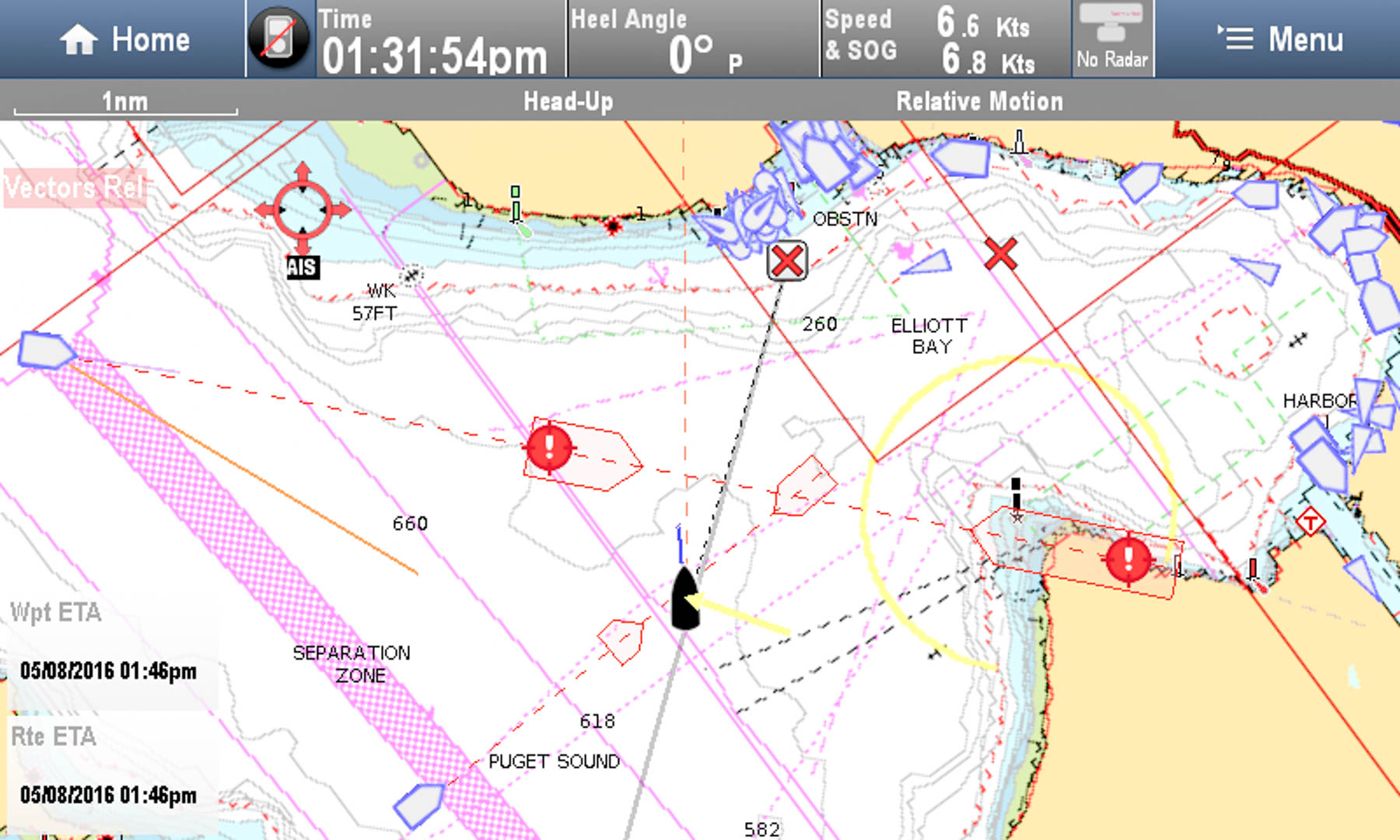
Only a few minutes after crossing the channel, the AIS collision avoidance warned that I was going to have an issue with inbound containership Cosco America. The collision tracking is represented by two ship like red objects with the exclamation points on them. Normally you’d only see the ship shapes, and not the exclamation points – this is because I tagged the vessel to show warning alerts and alarms.
As she got closer to us, those zones merged into one big red rectangle, indicating that if I continued my course and speed, we would likely collide inside that box. A few minutes after this screen shot, the actual AIS alarm went off in addition for a dangerous target, letting me know I needed to change something to avoid a collision.
You’ll also notice that there’s another vessel off my port side that is showing a collision plot – this was a Washington State Ferry that was headed from Bainbridge to Seattle. They altered course shortly afterwards to pass behind the Cosco America and were no longer a danger to me.
I really like what Raymarine has done to the iconography and usability of these features. So many other MFD’s and solutions out there have the AIS data, but display it in crazy ways, or only if there is an alarm. Raymarine chose to take that one step further and not only show you the types of ships moving around with different icons, but also plot more details about TCPA and other AIS data in a clear, meaningful way.
I highly recommend taking a look at their web pages on how these features work. Ben @ Panbo wrote some thoughts around this set of features as well, available at Raymarine AIS intercept graphics, better collision avoidance?
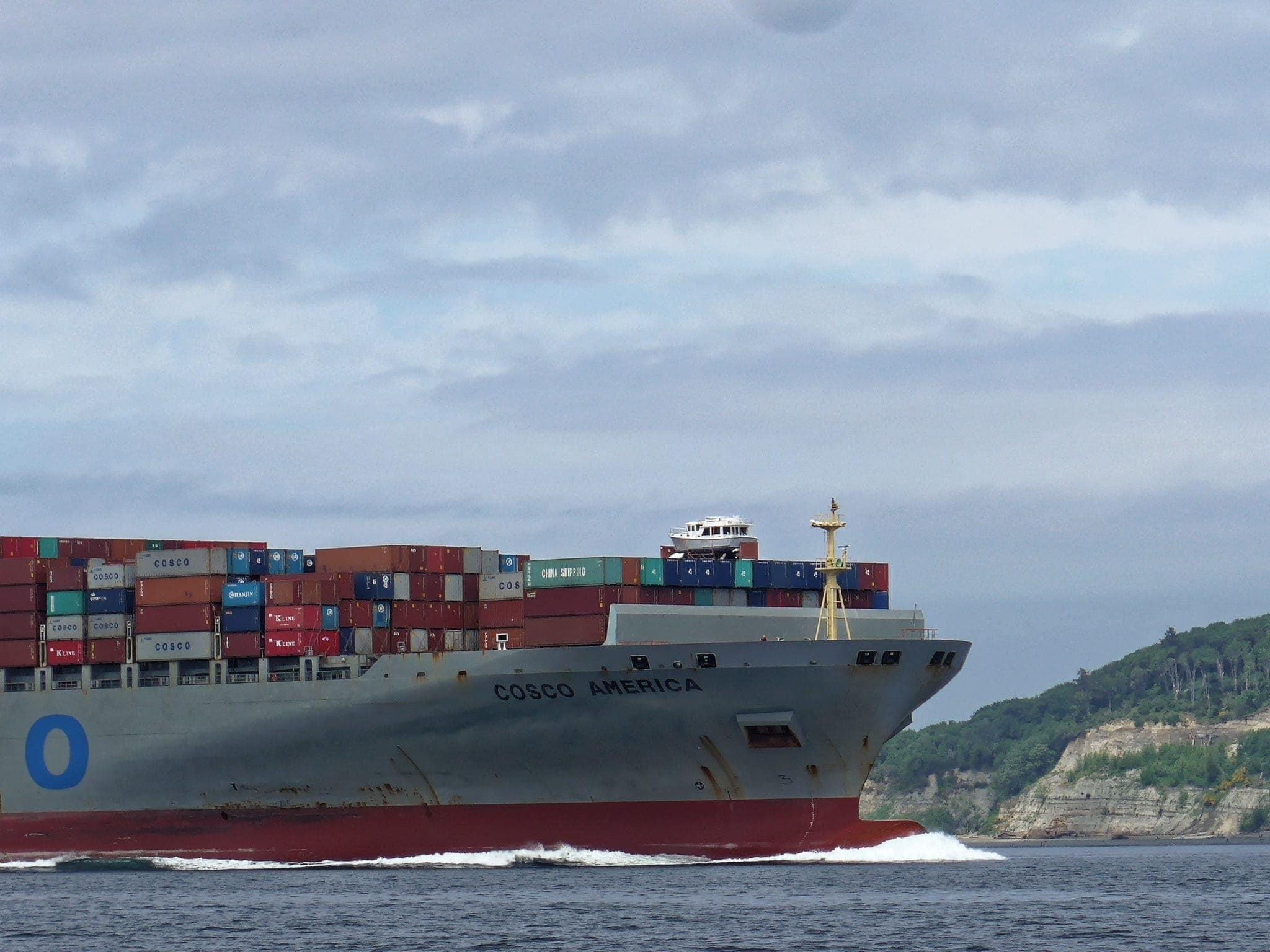
Even though she was slowing as she entered Elliott Bay, bound for the container terminal, Cosco America’s wake was still considerable, as I had experienced many times before. JJ and Josh were below napping a bit, so I rushed around and secured everything I could. Unbeknownst to me, the forward hatch was locked open at about an inch. On approaching the waves, I chose to take them straight on, as they were really much larger than usual. The second wave hit us really hard, knocking things down all over the place, and water entered through the forward hatch into the entire v-berth. The worst of it was a 2 hour job to clean up all of the water in tiny places, as well as air out the cushions. Lesson learned on looking at the hatches more closely.
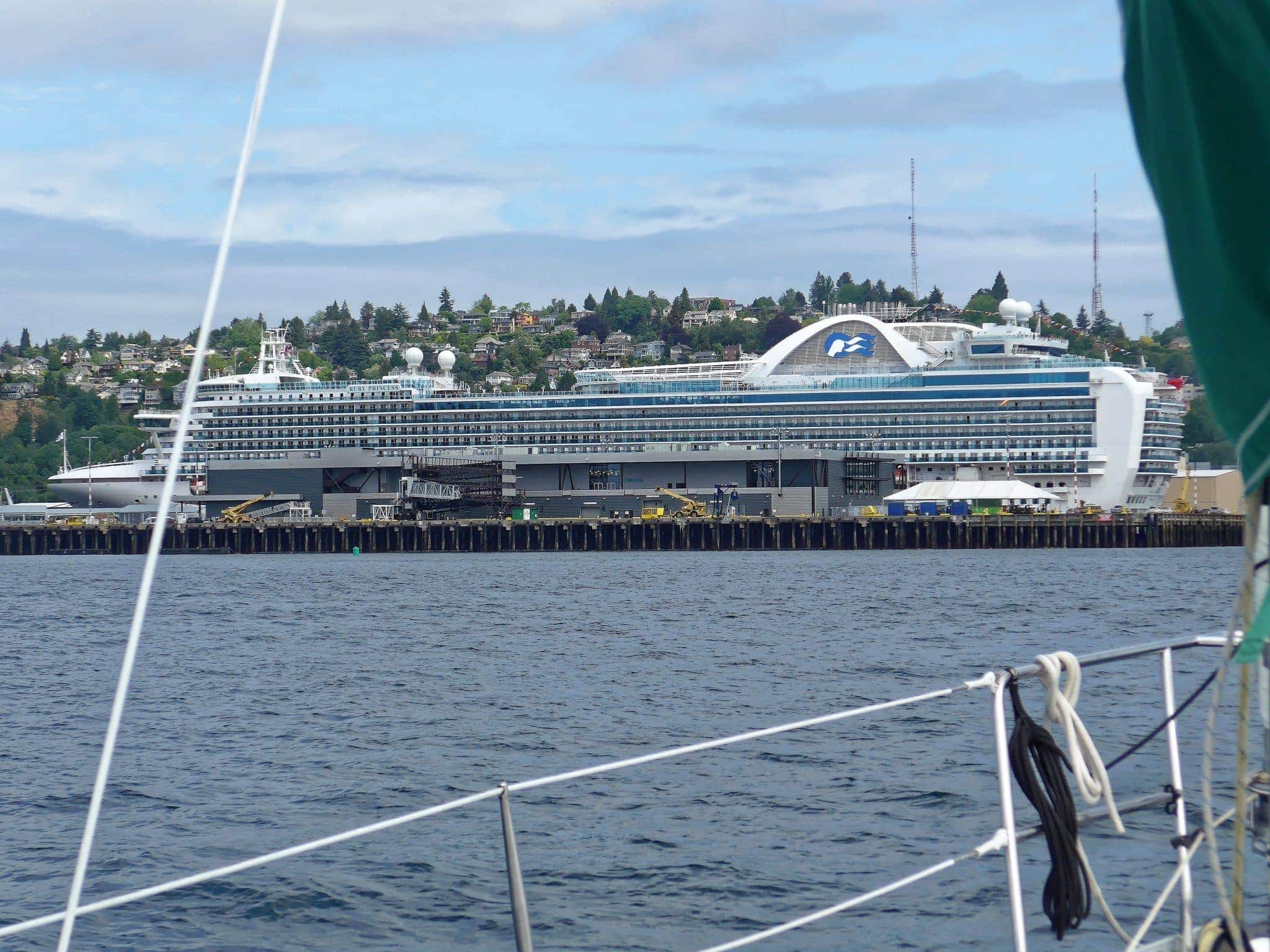
Right outside the entrance to our marina we saw the familiar sight of a cruise ship – the Ruby Princess. Seems that these start earlier and earlier every year – at least there was not one tied up at the close side of the pier, as is usual in summer.
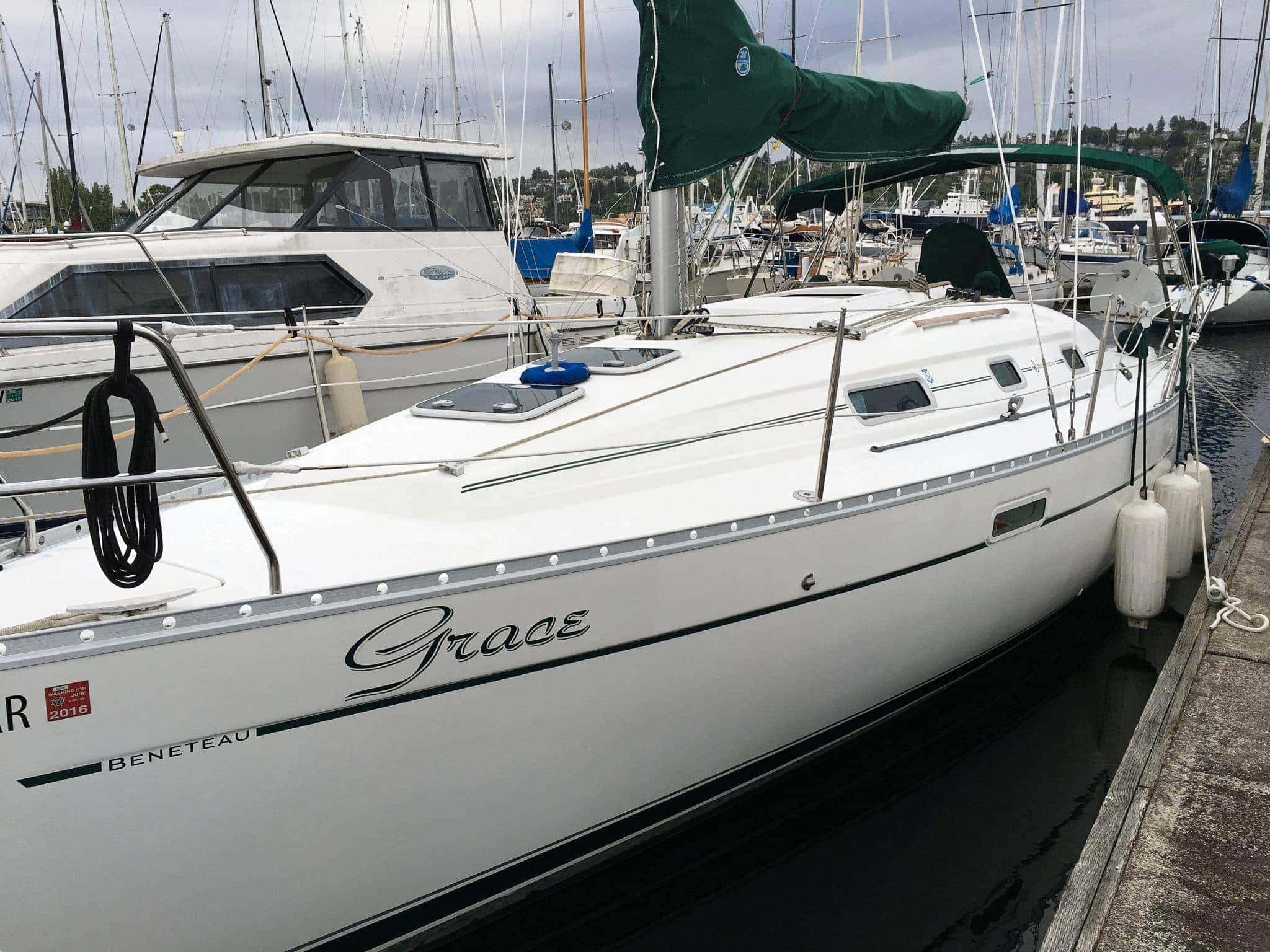
It was a very relaxing weekend in Port Orchard. I got to see a lot of ferries close up, spent some time playing with Raymarine features, and the guys had a great time with our usual exploring and activities. Port Orchard’s guest docks are really nice, and seem to be empty most of the time. Combine that with a wonderful walking path, nearby restaurants, and clean bathrooms, and it’s a great destination nearby Seattle.

